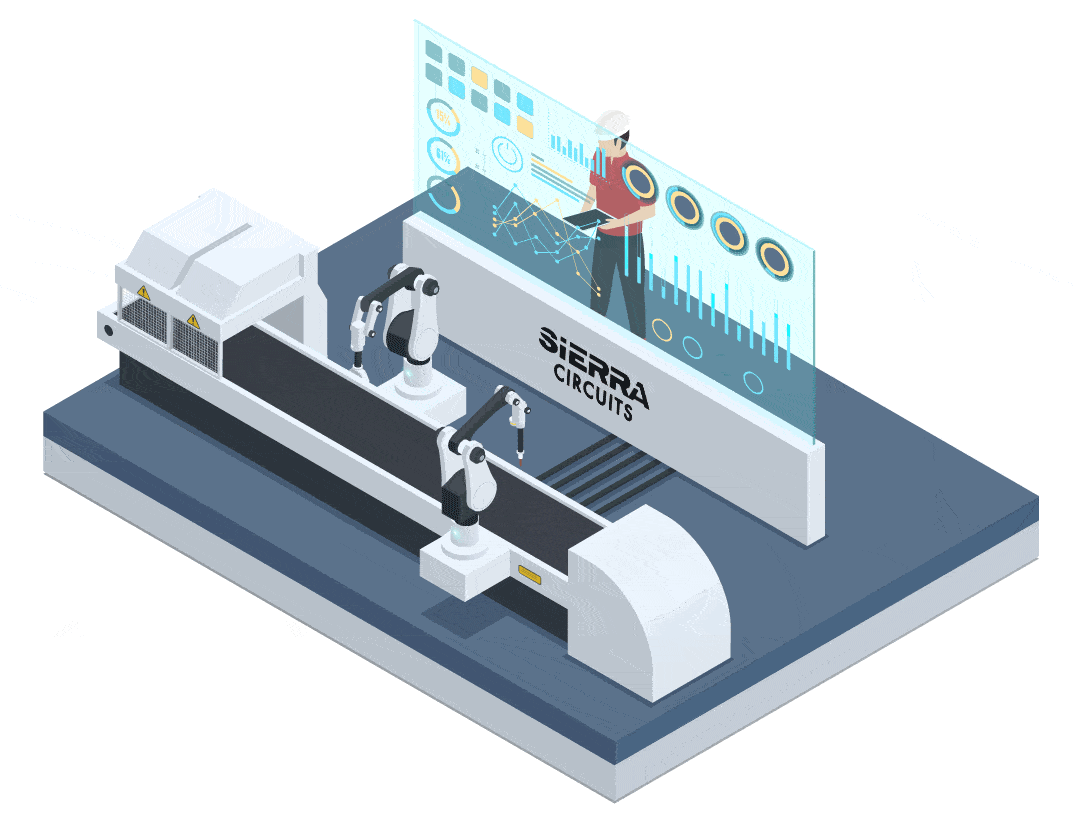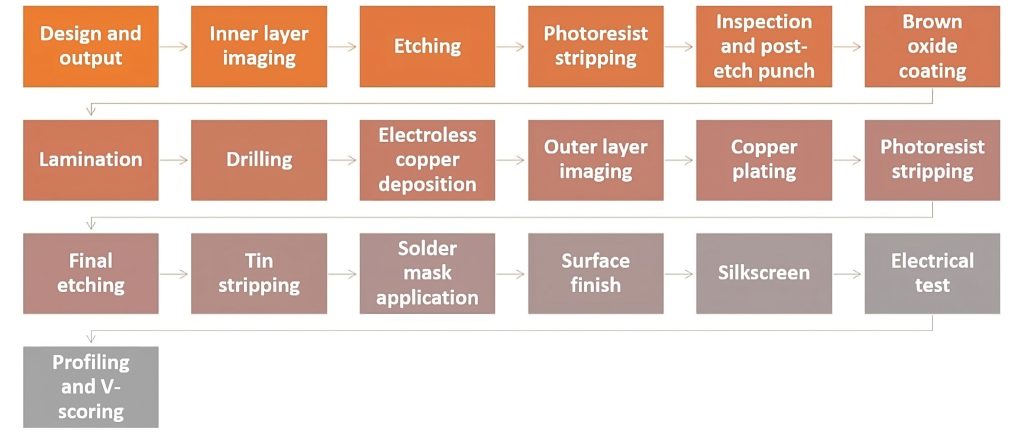How is a PCB manufactured?
PCB manufacturing process involves converting design files, which include Gerbers and netlists, into a physical circuit board on which components can be placed and soldered.

The fabrication process begins with design output files (Gerbers, netlist, drill files, etc.). These output files are generated during the design phase, which includes developing a product concept, schematic entry, layout design, and file generation. The next stages include manufacturing and assembly of the board.
The flow chart below shows the steps involved in PCB manufacturing.
Complete PCB manufacturing process

See our FAQ on PCB fabrication.
1. Design and board output files
Manufacturing commences soon after receiving the design files from a PCB designer. The designer creates the output files in Gerber or ODB++ format for fabrication and the bill of materials (BOM) for assembly.

The manufacturer performs DFM checks to identify potential risks and errors that might arise during the fabrication process. In case of any errors, the designer/customer is alerted about it. The corrected files are then fed to the CAM (computer-aided manufacturing) system to recognize the format of artwork layers, drilling data, IPC netlist, and translate the electronic data into images. It also verifies the layer order sequence, runs design rule checks (DRC), and performs many other operations.

Design for Manufacturing Handbook
10 Chapters - 40 Pages - 45 Minute ReadWhat's Inside:
- Annular rings: avoid drill breakouts
- Vias: optimize your design
- Trace width and space: follow the best practices
- Solder mask and silkscreen: get the must-knows
Download Now
Using the Gerber file as input, all the layers are analyzed. Stack-up planning will also be done accordingly. Later, CAM will create output files for various manufacturing departments. The output files include drill program (sub drill and main drill), imaging layers, solder mask file output, route file, and IPC netlist.

2. Inner layer imaging
Due to miniaturization, fabricators mostly use LDIs (laser direct imaging). They also use a special printer called plotter, which makes photo films of the circuit layers, solder mask, and silkscreen layers to print the circuit images. The panel consists of a layer of photo-sensitive film called a photoresist. The photoresist comprises a layer of photo-reactive chemicals that polymerize with exposure to ultraviolet light. This panel is now positioned under a computer-controlled laser. The computer scans the board surface and converts it into a digital image. This digital image matches with a pre-loaded CAD/CAM design file that contains the specifications for the desired image. In the same way, a negative image is developed on the inner layers.

The process flow of LDI is shown in the image below:

After developing the image, the unhardened photoresist (that protects the desired copper) is removed with an alkaline solution.
3. Etching
In the PCB manufacturing process, etching is a process of removal of unwanted copper (Cu) from the board. The unwanted copper is nothing but non-circuit copper. As a result, the desired circuit pattern is achieved.
Board manufacturers usually employ a wet etching process. In wet etching, the unwanted material gets dissolved when immersed in a chemical solution.

The important parameters to be considered during the etching process are the rate of panel movement, spray of chemicals, and amount of copper to be etched off. The whole process is implemented in a conveyorized, high-pressure spray chamber.
4. Photoresist stripping
In this process, the remaining photoresist is etched away from the copper. The process involves dissolving caustic pellets (chemical agents) in water with the use of a high-pressure water rinse, which breaks the photoresist.
5. Inspection and post-etch punch
With all the layers clean and ready, manufacturers ensure alignment holes are punched using targets provided on the inner layer for a better layer-to-layer registration. The layers are placed in an optical punch machine for accurate inner and outer layer alignment.
Inspection in this method is achieved by visual scanning of the board surface. The circuit board is illuminated by various light sources and one or more high-definition cameras are employed for this purpose. This is how an AOI (automated optical inspection) system can build a complete image of the board for verification.
6. Brown Oxide coating
Here the copper circuit pattern is coated with brown oxide to prevent oxidation and corrosion of inner layers post lamination. Also, it provides better adhesion properties for bonding with the prepregs.
7. Lamination
Lamination is the process of bonding prepreg, copper foil, and inner layer cores in a symmetrical stack-up under controlled temperature and pressure. This is a two-step process:
- Stack-up preparation
- Bonding
The multilayer board is made from copper foil, prepreg, and inner layer cores. These are bonded together with the application of heat and pressure. For better bonding, the mechanical press is used for hot and cold pressing. The bonding press computer manages the process of heating up the stack, applying pressure, and allowing the stack to cool at a controlled rate.

The following image summarizes the LDI process:

8. Drilling
During the drilling process, holes for vias and leaded components are drilled. An X-ray drill locates targets in the inner layer. The machine drills registration holes precisely. This machine is computer-controlled in which an operator can select a particular drill program. It locates the X-Y coordinates in the proper direction. It is possible to drill the holes down to 100 microns in diameter. The machine can also pick drills of the correct sizes and perform them accordingly.

Drilling produces elevated ends of metal which are commonly known as burrs. The deburring process removes any burrs or impurities from the surface of the board.

9. Electroless copper deposition
The first step in the plating process is to make the hole barrel conductive by means of chemical deposition of a very thin layer of copper on the hole walls. This process is called electroless copper deposition. This reaction is initiated by a catalyst. After a thorough cleaning, the panel goes through consecutive chemical baths. Around 0.08 to 0.1 micron thick copper layer gets deposited on the hole barrel as well as the surface of the panel.

10. Outer layer imaging
We used photoresist on the panel for inner-layer imaging. Similarly, imaging will be conducted for the outer layers of the panel using a positive image. Here, the process follows print-plate-etch method. The first step involves cleaning the panels to prevent contaminants and dust particles from sticking to them. Next, a layer of photoresist is applied to the panel. Right after this, LDIs are used to print the image.
11. Copper plating
In this step, the holes and surface are electroplated with copper. The panels are loaded into the flight bars by the operator. The panels act as cathodes that electroplate the hole and the surface since the holes already have a thin layer of conductive copper deposited that enables electroplating. It is done with the automated plating lines. The panels are cleaned and activated in multiple baths before they are electroplated. Every set of panels is computer-controlled to ensure that they stay in each bath precisely for a particular duration. Usually, the deposition will be 1-mil thick copper inside the hole barrel.

After the plating of copper, next is tin plating. Tin plating acts as an etch resist. It prevents corrosion of surface features such as copper pads, hole pads, and hole walls during the etching of the outer layer.

12. Photoresist stripping
Once the panel has been plated the photo-resist becomes undesirable and needs to be stripped from the panel in order to expose the unwanted copper. Here, a single continuous process line is used to dissolve and wash off the resist which covers the unwanted copper. This is the first phase of the strip-etch-strip procedure.

13. Final etching
The unwanted exposed copper is removed using an ammoniacal etchant during this step. In the meantime, the tin secures the required copper. At this point, the conducting areas and connections are properly established.

14. Tin stripping
Post etching, the tin layer present on the copper tracks will be removed. Concentrated nitric acid is used to remove the tin and it doesn’t damage the copper circuit tracks present underneath it. This produces a clear, distinct outline of copper on the PCB.

15. Solder mask application
Solder mask serves the following purposes:
- It provides insulation resistance to the traces.
- Distinguishes solderable and non-solderable areas.
- Provides protection against environmental conditions by covering non-solderable areas with ink.
LPI (liquid photo imageable) mask combines solvents with polymers to produce a thin coating that adheres to different circuit board surfaces. A printer images the coated panel. A UV lamp in the machine hardens the ink in the transparent areas. Later, all the unhardened resist is stripped off from the imaged panel.
LPI curing (drying) merges the ink with the dielectric. It facilitates the bonding of the solder mask. A final baking step is carried out either in an oven or under infrared heat sources.

Green was chosen as the typical solder mask color because it doesn’t strain the eyes. All inspections were done manually before machines could inspect PCBs during the production and assembly process. The top light used by technicians to inspect the boards does not reflect off of a green solder mask, making it safer for their eyes.
16. Surface finish
PCB surface finishes are intermetallic joints between the bare copper on the solderable area of the circuit board and the components. A base copper surface of the board is susceptible to oxidation without a protective coating. Therefore, surface finish application is essential to protect it from oxidation. Additionally, it prepares the surface for soldering components onto the board during assembly and extends the shelf-life of the board.
There are various types of surface finishes. However, lead-free surface finishes are widely used because of the strict RoHS norms.

While choosing a surface finish, consider the factors such as cost, environment, component selection, shelf life, and production volume.

17. Silkscreen
In this process, inkjet projectors are used to image the legends directly from the board’s digital data. The ink is silkscreened (spread) on the surface of the panel using a jet printer. The panels are then baked to cure the ink. It designates different kinds of text such as part number, name, code, logos, etc.
There are three types of printing:
- Manual screen printing
- Direct legend printing

18. Electrical test
E-test stands for bare printed circuit board electrical testing. During this step, electrical probes are used to check each unpopulated board for shorts, opens, resistances, capacitances, and other fundamental electrical properties. E-test checks the electrical conductivity of the circuit board based on the netlist file. A netlist consists of the information on conductivity interconnection patterns of a PCB.
Bed of nails and flying probe tests are implemented to test for functionality.

Flying probe testing
Flying probe testing uses probes that move from one point to another according to the instructions provided by specific software. It is a fixtureless test method. In the beginning, flying probe test programs (FPT) are generated and then loaded into the FPT tester. The tester applies electrical signals and powers to the probe points and then measures them according to the test program.
Bed of nails
Bed of nails is a conventional method of electrical testing for bare boards. It requires the creation of a test template with pins aligned to test locations on the PCB. The process is fast and suitable for mass production systems.
19. Profiling and v-scoring
Circuit boards are profiled and cut out of the production panel in the final PCB manufacturing stage. The method employed either uses a router or a v-groove. The v-groove cuts diagonal channels on both sides of the board, while the router leaves little tabs along the borders. The boards can simply pop out of the panel in any case.

Sierra Circuits’ engineers and technicians have the experience to bring your rigid PCBs to life.













